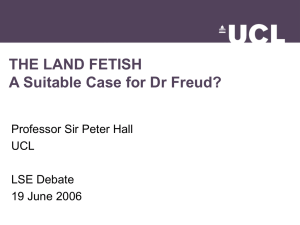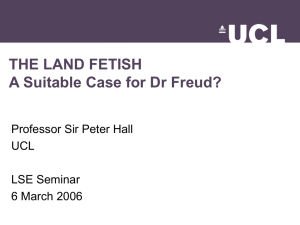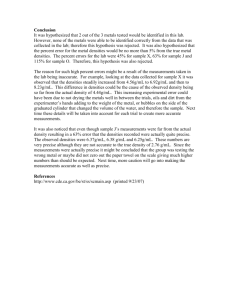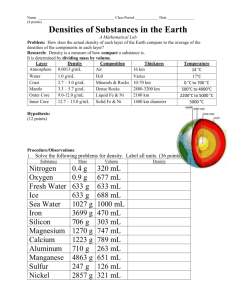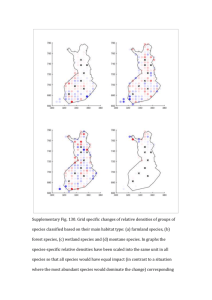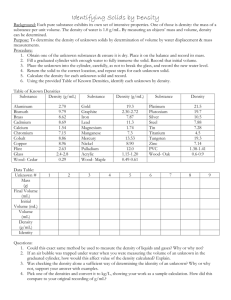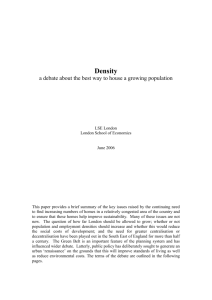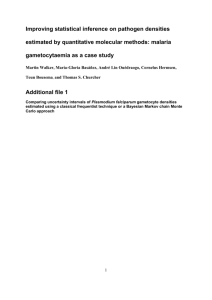The LSE London Density Debate 19 June 2006
advertisement
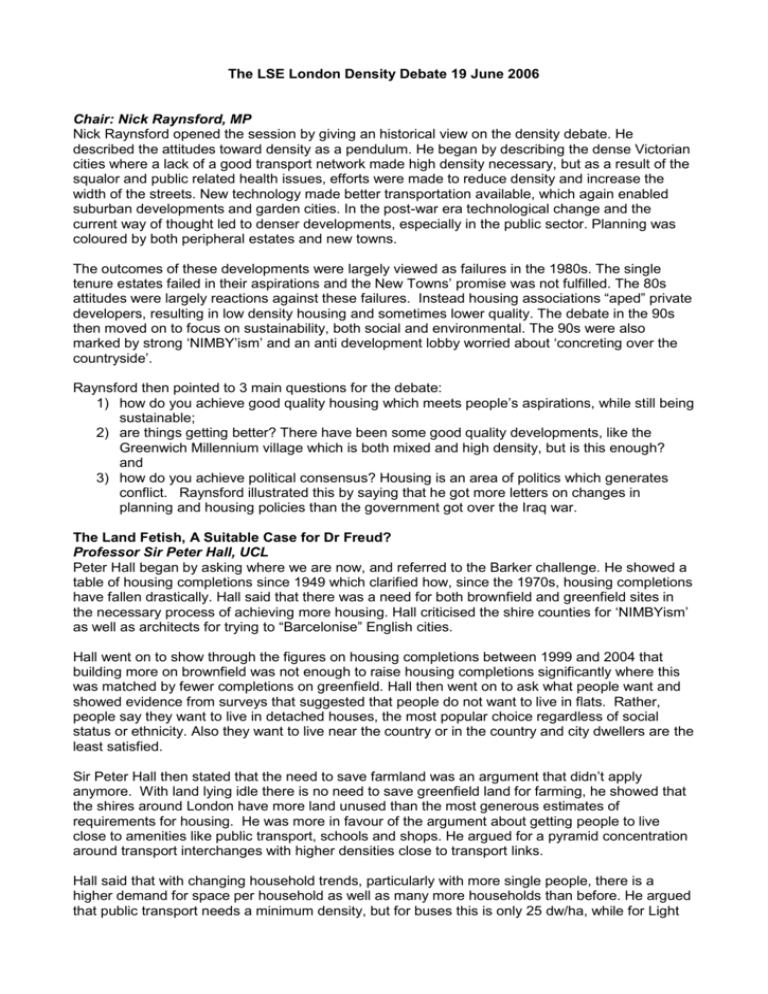
The LSE London Density Debate 19 June 2006 Chair: Nick Raynsford, MP Nick Raynsford opened the session by giving an historical view on the density debate. He described the attitudes toward density as a pendulum. He began by describing the dense Victorian cities where a lack of a good transport network made high density necessary, but as a result of the squalor and public related health issues, efforts were made to reduce density and increase the width of the streets. New technology made better transportation available, which again enabled suburban developments and garden cities. In the post-war era technological change and the current way of thought led to denser developments, especially in the public sector. Planning was coloured by both peripheral estates and new towns. The outcomes of these developments were largely viewed as failures in the 1980s. The single tenure estates failed in their aspirations and the New Towns’ promise was not fulfilled. The 80s attitudes were largely reactions against these failures. Instead housing associations “aped” private developers, resulting in low density housing and sometimes lower quality. The debate in the 90s then moved on to focus on sustainability, both social and environmental. The 90s were also marked by strong ‘NIMBY’ism’ and an anti development lobby worried about ‘concreting over the countryside’. Raynsford then pointed to 3 main questions for the debate: 1) how do you achieve good quality housing which meets people’s aspirations, while still being sustainable; 2) are things getting better? There have been some good quality developments, like the Greenwich Millennium village which is both mixed and high density, but is this enough? and 3) how do you achieve political consensus? Housing is an area of politics which generates conflict. Raynsford illustrated this by saying that he got more letters on changes in planning and housing policies than the government got over the Iraq war. The Land Fetish, A Suitable Case for Dr Freud? Professor Sir Peter Hall, UCL Peter Hall began by asking where we are now, and referred to the Barker challenge. He showed a table of housing completions since 1949 which clarified how, since the 1970s, housing completions have fallen drastically. Hall said that there was a need for both brownfield and greenfield sites in the necessary process of achieving more housing. Hall criticised the shire counties for ‘NIMBYism’ as well as architects for trying to “Barcelonise” English cities. Hall went on to show through the figures on housing completions between 1999 and 2004 that building more on brownfield was not enough to raise housing completions significantly where this was matched by fewer completions on greenfield. Hall then went on to ask what people want and showed evidence from surveys that suggested that people do not want to live in flats. Rather, people say they want to live in detached houses, the most popular choice regardless of social status or ethnicity. Also they want to live near the country or in the country and city dwellers are the least satisfied. Sir Peter Hall then stated that the need to save farmland was an argument that didn’t apply anymore. With land lying idle there is no need to save greenfield land for farming, he showed that the shires around London have more land unused than the most generous estimates of requirements for housing. He was more in favour of the argument about getting people to live close to amenities like public transport, schools and shops. He argued for a pyramid concentration around transport interchanges with higher densities close to transport links. Hall said that with changing household trends, particularly with more single people, there is a higher demand for space per household as well as many more households than before. He argued that public transport needs a minimum density, but for buses this is only 25 dw/ha, while for Light Rails it is 60 dw/ha. Hall suggested pyramids up to 60 dw/ha around rail stations, with less dense developments further out. To sum up Hall said that there is a need to deliver enough houses and that one should look at developing a balance between brownfield and greenfield. He argued for sustainable urban places linked to transport corridors making the countryside available for people was the best way forward. Anne Power, LSE Anne Power began her session by saying that she believed that Peter Hall lived in a fantasy world and that what he wanted cannot be delivered. She continued by saying that the understanding of density is crucial, and that while there has been a lot of successes with density there has also been failures. She stressed that it is important to plan for sustainable development. Power addressed some of the negative images that the word density projects: council tower blocks, overcrowding, family deprivation and cities like Hong Kong. She then went on to show that there are also many positive images of density like old grey stone flats in Edinburgh, Georgian terraces in inner London, dense blocks in Paris and the cathedral cities of York, Chester and Lancashire. She pointed out that density can very well correlate positively with high value. Power then went on to say that density is a critical issue because households are changing size and becoming smaller, with fewer children, later marriage and child bearing, more lone parents and longer life expectancies. The changes in household size have halved the people density per dwelling and made many services unviable. Power went on to say that density is a crucial issue because of shrinking land supply. The problems arise from population growth, lower density building, urban sprawl, growth of car use and roads, in addition to increased wealth among the population who demand more space, and environmental constraints such as shortage of water and providing for waste and traffic. Power further said that you need a critical mass of people to support services like transport, shops and schools, and that 50 homes per hectare is the minimum viable density for community provision. Density is also a way of achieving the proximity necessary for social provision, mixed communities, social integration and safety. Power argued that higher density is also a way of conserving popular green fields and protecting flood plains. The current patterns in the UK are unsustainable, with the worst congestion and car use in Europe, great flood threats and high costs of infrastructure for new settlements. Power concluded by saying that density was a tool in providing sustainable settlements, which would help cut down energy use, provide alternatives to the car, support a large elderly population, prevent racial separation and protect the environment. Christine Whitehead, LSE Christine Whitehead began by asking whether achieving density, however committed we are to the principal, would actual work. She raised three issues with respect to achieving desirable outcomes: the difference between the density planned and the actual densities achieved; the implications this had for effective use of stock, prices and affordability; and thirdly what alternative and complementary approaches there are to optimise densities. Whitehead stated that with rising living standards people will want more space and will be willing to pay for that space. As a result the actual densities are likely to be lower than planned in market housing, while those in social housing vary from too crowded to significant ‘under-occupation’. As important to the community urban space often generates higher value to the community than vacant land at the margin of the urban area. The current approach to new building means that although output levels have been rising in London at least the total quantity of living space may actually be falling because of the reduction in the average size of new units. Morever flats have higher vacancy rates and lower utilisation than houses, mainly because of higher turnover, but also keeping the property off the market. This may be partly due to investment policies, partly to the types of household in rented housing and partly to the relative desirability of the units built. As a result the relative prices of flats and houses, and new and older units are rapidly changing, which brings out concerns about potential residualisation and being able to maintain mixed communities. There are also concerns about long term risks with respect to flats because they tend to have higher service charges and require more management. Whitehead also pointed to evidence that showed that those who lived comfortably in cities by choice may well have second homes. They also use services in the suburbs which leads to more journeys and less sustainability than predicted. Whitehead went on to discuss what is needed. She said that if social costs are the reason for encouraging higher densities then one should address the problems within the existing stock and increase the costs of space to reflect measured externalities. In the same way if infrastructure is the argument, then one should modify pricing policies to reflect the true cost. There is a general need for more sophisticated policies relating cost to value. Such policies would be unpopular politically, both because of the implied shift to greenfield land development and the fact that taxation of space would hit the middle classes and particularly older households harder. But, Whitehead concluded, current policy is incoherent and likely to become more costly over time. A Case for Density? Well Maybe Michael Edwards, UCL Michael Edwards stated that the discussion around density was complicated and that he was a bit ambivalent about arguing strongly on either side. Although some density increase would be beneficial he did not support every density increment and high density living is not for everyone as people vary. It should anyways not come at the expense of quality. Edwards went through the arguments. First he agreed with Peter Hall that land saving was a weak argument. Then with respect to densities supporting local services, he asked if we knew how these two things actually affected each other. He also asked to what degree we knew that density supported non-car modes of travel and whether predicting people’s actions might be more complicated than assumed by the simplistic predictions. Edwards also suggested that people in different economic or social classes feel the impacts of higher densities differently and there are therefore varying costs and benefits across household groups. Edwards said that we were not yet currently in a position to answer these important questions. He stressed that new building only adds 1-2% to the total stock each year. The emphasis would in any case have to be on quality and that the objectives will have to be clarified. He also pointed out that the way of measuring density gave a poor picture as it measure dwelling instead of people and we do not know what the space per person is or how it compares between rich and poor. Edwards said that we should know and that any evidence base is a necessary part of policy development, and that the rest of Europe does measure this. He added that questionnaires asking how people want to live do not give a good picture as they are too detached from reality. Comments from the Floor When the discussion was opened to the floor, people brought up the costs of density in relation to infrastructure; the importance of more housing; the need for high quality and variety; and people’s behaviour in relation to density. It was pointed out that density seems to be one solution to many different problems. He questioned whether higher density in practice actually leads to mixed communities and whether density is enough to make people change their transport decisions. He said that we know the first order effects of higher densities, which is higher prices, what the second order effects are we do not know and should discover. The impact of higher densities on transport policy was questioned and it was pointed out that higher densities also mean more congestion. It was suggested that the difference between Peter’s 40 pph is not that far from Anne’s 50 pp. It is the quality of the development that should be the focus and the fact that there is a need for more houses in the South East. It was pointed out that people generally dislike development on brownfield as much as they dislike building on greenfield if it is near them. It was also mentioned that there needs to be greater variety, and that one should speak of average densities and variations around this average instead of minimum densities. There was a wide ranging discussion of how people’s behaviour affected how things play out in reality, and of the fact that people want to live in their own house. It was said that aspirations are the key problem: as long as they are high there will be shortages. If there is a desire to revive the cities, then quality of life is essential and the focus needs to be on schooling, health, security etc. A member of the audience asked for more innovative architecture that would be more sustainable and that would address issues such as density. Another consistent theme was the provision and cost of infrastructure and in particular it was also asked who is going to plan and provide the strategic planning and who will pay for the infrastructure such as roads, sewage etc. Finally it was stressed that it is important to keep in mind that density must be a means to an end not an end to a means. Closing Remarks Peter Hall closed by saying that there was a danger of sub-standard housing being built and said that the important issue was to build a lot more houses of good quality. Anne Power stated that cities are economic drivers and that there was a need to make them work and that higher density supported environmental imperatives and social cohesion. She supported speakers who had called for more innovation. Christine Whitehead said that there was a need for more political strategic planning and a closer look at the outcomes on the ground. Michael Edwards closed by saying that price signals from the market economy do not work perfectly for everyone, and even in a perfect market only those who have money get housing. He also called for more variety from architects and for improving the image of new-build. People will have to have positive experiences to support the agenda. Nick Raynsford summed up by saying that the way forward was to focus on better quality developments, and that good greenfield developments were needed to change people’s views. He added that we were not building enough, there was a need for both more housing as well as renovation and regeneration of the current stock.
